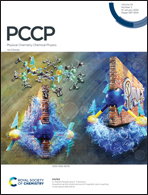Theoretical insights into TM@PHEs as single-atom catalysts for water splitting based on density functional theory†
Abstract
Single-atom catalysis is the new frontier of heterogeneous catalysis and has attracted considerable attention as it exhibits great potential in hydrogen evolution to mitigate energy crisis and environmental issues. The support materials for single-atom catalysts (SACs) play a significant role in stabilizing the metal atoms, preventing their aggregation, and enhancing the catalytic activity. Two-dimensional sp2 hybridized PHE–graphene might be a real support for SACs due to the potential energy well induced by its enneagon, hexagon and pentagon carbon rings. In this study, eleven transition metal (TM) atoms adsorbed on PHE–graphene (TM@PHEs) are taken into account based on density functional theory (DFT) and PHE-graphene is proved to be an ideal single-atom carrier for water splitting. In particular, the TM@PHEs (TM = Fe, Ni, Ru, and Pd) exhibit high catalytic activity toward the hydrogen evolution reaction (HER). The reaction path of water splitting is also determined. Due to their much lower energy barrier, both Fe@PHE and Ru@PHE are more promising SACs. In addition, the charge density difference, Bader charge analysis and spin projected density of states (PDOS) are investigated.



 Please wait while we load your content...
Please wait while we load your content...